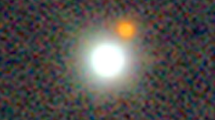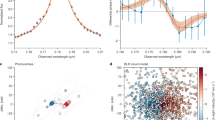Abstract
Microquasars are stellar-mass black holes in our Galaxy that mimic, on a smaller scale, many of the phenomena seen in quasars. Their discovery opens the way for a new understanding of the connection between the accretion of matter onto black holes and the origin of the relativistic jets observed in remote quasars.
This is a preview of subscription content, access via your institution
Access options
Subscribe to this journal
Receive 51 print issues and online access
$199.00 per year
only $3.90 per issue
Buy this article
- Purchase on Springer Link
- Instant access to full article PDF
Prices may be subject to local taxes which are calculated during checkout



Similar content being viewed by others
References
Mirabel, I. F. et al. Adouble-sided radio jet from the compact Galactic Centre annihilator 1E1740.7-2942. Nature 350, 215–218 (1992).
Mirabel, I. F. & Rodríguez, L. F. Asuperluminal source in the galaxy. Nature 371, 46–48 (1994).
Tingay, S. J. et al. Arelativistically expanding radio source associated with GRO J1655-40. Nature 374, 141–143 (1995).
Hjellming, R. M. & Rupen, M. P. Episodic ejection of relativistic jets by the X-ray transient GRO J1655-40. Nature 375, 464–467 (1995).
Shapiro, S. L. & Teukolsky, S. A. Black Holes, White Dwarfs, and Neutron Stars 441 (Wiley, New York, 1983).
Rodríguez, L. F. & Mirabel, I. F. Repeated relativistic ejections in GRS 1915+105. Astrophys. J. (submitted).
Mirabel, I. F. et al. Accretion instabilities and jet formation in GRS 1915+105. Astron. Astrophys. 330, L9–L12 (1998).
Eikenberry, S. S. et al. Evidence for disk-jet interaction in the microquasar GRS 1915+105. Astrophys. J. 494, L61–L64 (1998).
Pearson, T. J. & Zensus, J. A. in Superluminal Radio Sources (eds Zensus, J. A. & Pearson, T. J.) 1–11 (Cambridge Univ. Press, 1987).
Castro-Tirado, A. J. et al. Discovery and observations by Watch of the X-ray transient GRS 1915+105. Astrophys. J. Suppl. Ser. 92, 469–472 (1994).
Zhang, S. N., Wilson, C. A., Harmon, B. A., Fishman, G. J. & Wilson, R. B. X-ray nova in Scorpius. IAU Circ. No. 6046 (1994).
Hjellming, R. M. & Johnston, K. J. An analysis of the proper motions of SS433 radio jets. Astrophys. J. 246, L141–L145 (1981).
Harmon, B. A. et al. Hard X-ray signature of plasma ejection in the galactic jet source GRS 1915+105. Astrophys. J. 477, L85–L90 (1997).
Foster, R. S. et al. Radio and X-ray variability of the galactic superluminal source GRS 1915+105. Astrophys. J. 467, L81–L84 (1996).
Mirabel, I. F. et al. Infrared observations of an energetic outburst in GRS 1915+105. Astrophys. J. 472, L111–L114 (1996).
Zhang, S. N. et al. in Proceedings of the 4th Compton Symposium (eds Dermer, C. D., Strickman, M. S. & Kurfess, J. D.) 141–162 (AIP Conf. Proc. 410, 1997).
Blandford, R. D. & Payne, D. G. Hydromagnetic flows from accretion discs and the production of radio jets. Mon. Not. R. Astron. Soc. 199, 883–894 (1982).
Blandford, R. D. & Znajek, R. L. Electromagnetic extraction of energy from Kerr black holes. Mon. Not. R. Astron. Soc. 179, 433–440 (1977).
Zhang, S. N., Cui, W. & Chen, W. Black hole spin in X-ray binaries: observational consequences. Astrophys. J. 482, L155–L158 (1997).
Morgan, E. H., Remillard, R. A. & Greiner, J. RXTE observations of QPOs in the black hole candidate GRS 1915+105. Astrophys. J. 482, 993–1010 (1997).
Nowak, M. A., Wagoner, R. V., Begelman, M. C. & Lehr, D. E. The 67 Hz feature in the black hole candidate GRS 1915+105 as a possible “diskoseismic” mode. Astrophys. J. 477, L91–L94 (1997).
Cui, W., Zhang, S. N. & Chen, W. Evidence for frame-dragging around spinning black holes in X-ray binaries. Astrophys. J. 492, L53–L57 (1998).
Greiner, J., Morgan, E. H. & Remillard, R. A. Rossi X-ray timing explorer observations of GRS 1915+105. Astrophys. J. 473, L107–L110 (1996).
Belloni, T., Méndez, M., King, A. R., van der Klis, M. & van Paradijs, J. An unstable central disk in the superluminal black hole X-ray binary GRS 1915+105. Astrophys. J. 479, L145–L148 (1997).
Chen, X., Swank, J. H. & Taam, R. E. Rapid bursts from GRS 1915+105 with RXTE. Astrophys. J. 477, L41–L44 (1997).
Narayan, R., Garcia, M. R. & McClintock, J. E. Advection-dominated accretion and black hole event horizons. Astrophys. J. 478, L79–L82 (1997).
Pooley, G. & Fender, R. P. Quasi-periodic variations in the radio emission from GRS 1915+105. Mon. Not. R. Astron. Soc. (in the press).
Rodríguez, L. F. & Mirabel, I. F. Sinusoidal oscillations in the radio flux of GRS 1915+105. Astrophys. J. 474, L123–L125 (1997).
Fender, R. P., Pooley, G. G., Brocksopp, C. & Newell, S. J. Rapid infrared flares in GRS 1915+105: evidence for infrared synchrotron emission. Mon. Not. R. Astron. Soc. 179, L65–L69 (1997).
Acknowledgements
We have benefited from discussions with colleagues at the Goddard workshop on Microquasars, and we thank J. Swank and A. Harmon for organizing this workshop.
Author information
Authors and Affiliations
Corresponding author
Rights and permissions
About this article
Cite this article
Mirabel, I., Rodríguez, L. Microquasars in our Galaxy. Nature 392, 673–676 (1998). https://doi.org/10.1038/33603
Issue Date:
DOI: https://doi.org/10.1038/33603
This article is cited by
-
Advective accretion flow properties around rotating black holes – application to GRO J1655-40
Journal of Astrophysics and Astronomy (2018)
-
A galactic microquasar mimicking winged radio galaxies
Nature Communications (2017)
-
Solar Science with the Atacama Large Millimeter/Submillimeter Array—A New View of Our Sun
Space Science Reviews (2016)
-
Relativistic baryonic jets from an ultraluminous supersoft X-ray source
Nature (2015)
Comments
By submitting a comment you agree to abide by our Terms and Community Guidelines. If you find something abusive or that does not comply with our terms or guidelines please flag it as inappropriate.



